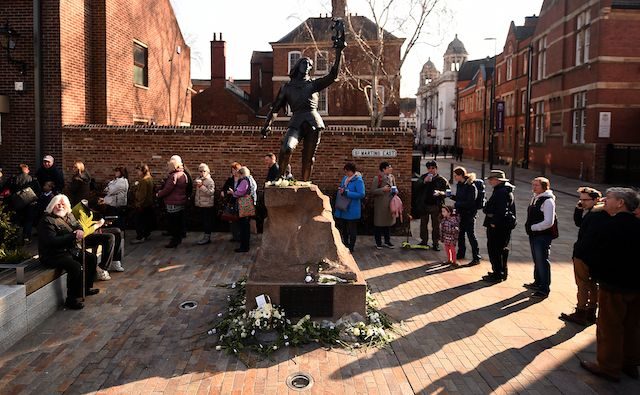SUMMARY
This is AI generated summarization, which may have errors. For context, always refer to the full article.

LEICESTER, United Kingdom – Thousands queued up on Monday to pay their respects to King Richard III of England, whose remains were found in a car park over 500 years after his death and will be reburied this week.
Vilified since his death on the battlefield at Bosworth in 1485, the English king is now apparently being rehabilitated in British hearts after some 35,000 people lined the streets of Leicester in central England to view his funeral cortege Sunday.
A requiem mass – a Catholic prayer ceremony for the deceased – is due to be celebrated in the city later on Monday, part of five days of events leading up to the king’s reinterment at Leicester’s medieval cathedral on Thursday.
“Richard was not a man of peace. The times in which he lived and the role into which he was born did not permit that. But now we pray for his eternal peace,” Cardinal Vincent Nichols is expected to say in a homily.
The monarch’s coffin was draped in a dark pall and flanked by armed forces veterans, as visitors filed past.
One of those viewing the coffin, 80-year-old David Davies, said: “With such a chequered history, even after death, it does still demand recognition as he is a king.”
The Bishop of Leicester, Tim Stevens, added that there was a “tone of recognition” in the city as it remembered the fallen monarch.
“Whatever your faith, or whatever part of the tradition you come from, as that coffin entered the church you are brought face to face with your own mortality,” he added.
Richard’s remains were sealed in a lead box, and his bones packed in with woollen fleece, wadding and unbleached linen. Small bones were placed in linen bags, and a rosary placed inside.
The box is inside a 1.8-meter-long oak coffin, made by Canadian carpenter Michael Ibsen, who is Richard’s nephew 16 times removed and his closest living relative.
DNA match
Richard, the last of the Plantagenet dynasty, ruled England from 1483 until he was killed near Leicester by soldiers loyal to Henry Tudor, later Henry VII.
The slain 32-year-old was buried without fanfare at Greyfriars monastery, which was demolished in the 1530s and Richard’s remains were thought lost.
But a team of enthusiasts unearthed them in 2012 and matching Ibsen’s DNA to that of the skeleton found under a municipal car park helped identify Richard’s remains.
Another was the skeleton’s distinctive curved spine which matched descriptions of the king at the time, and radiocarbon analysis dating the skeleton to between 1455 and 1540.
The discovery of his skeleton encouraged scholars to look again at Richard’s record of social reform, rather than rely on Shakespeare’s Tudor-era portrayal of him as a murderous tyrant.
Historians credit Richard for developing the presumption of innocence in the legal system and the practice of granting bail.
However, he is also accused in Shakespeare’s play “Richard III” of killing his nephews to claim the throne. – Charlotte Turner,AFP / Rappler.com
Add a comment
How does this make you feel?
There are no comments yet. Add your comment to start the conversation.